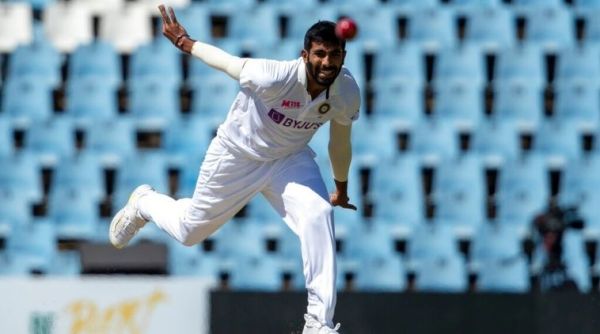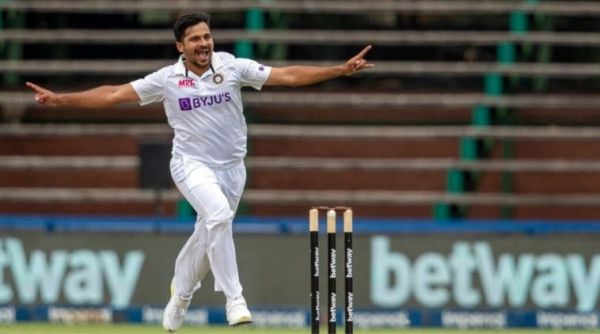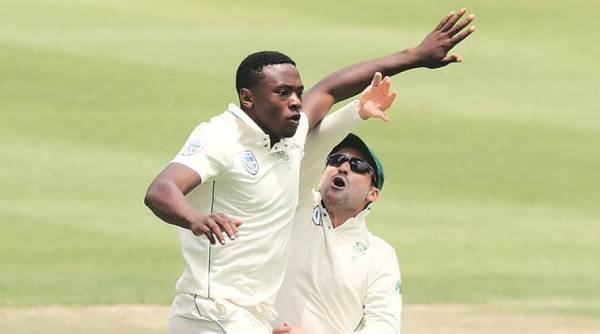 The best of South Africa’s seamers produced their best at this most scenic of venues, better suited for a leisurely barbecue afternoon than five days of spine-chilling, intense cricket. (Twitter/ICC)
The best of South Africa’s seamers produced their best at this most scenic of venues, better suited for a leisurely barbecue afternoon than five days of spine-chilling, intense cricket. (Twitter/ICC) Whisper Cape Town and the mental images roll out as instantly as the frame of the majestic Table Mountain in the backdrop of the arena. You could see the gnarl of Allan Donald and the snarl of Dale Steyn; the sneer of Shaun Pollock and the stare of Kagiso Rabada. You could see the fear in batsmen’s eyes and the quiver of their knees too.
The best of South Africa’s seamers produced their best at this most scenic of venues, better suited for a leisurely barbecue afternoon than five days of spine-chilling, intense cricket. Here, Dale Steyn has 74 wickets at 21; his trusted accomplice Vernon Philander has grabbed 53 at 18.2; Shaun Pollock’s 51 have come at 19 while Allan Donald has nabbed 30 at 22, a haul his latest heir Rabada has already surpassed (35 at 21). There wouldn’t be an apter venue for the supremely-skilled pace-bowling batteries of South Africa and India to settle the series.
If there is nothing more uplifting or hair-raising in the theatre of cricket than the sight of great fast bowlers, sweat-glistened, sun on his back, the series had plenty of such moments to be treasured for ages. There was a microcosm of fast-bowling’s most vaunted skills. The inexorable genius of Jasprit Bumrah was brimming at the Supersport Park—he is perhaps fast-bowling’s equivalent of Shane Warne sans the showboating. The virtuoso of his craft just keeps unfolding different, and beautiful, layers, so much so that his talent seems a bottomless pit of ingenuity. There is so much you could see of Bumrah; there seems to be so much more to be seen too. A new trick, or a tease, an idea or an improvisation seems just round the corner.
 Jasprit Bumrah (AP)
Jasprit Bumrah (AP) So much so that his wizardry overshadows the masterfulness of his fast-bowling colleague Mohammed Shami, an expert seam merchant himself. There are few tricks he can’t do that Bumrah can. Maybe, the yorker and the assorted slower balls. but he could arguably brag about a more potent short-ball and the heavy ball that bursts awkwardly into the batsmen.
Under arguably the most lethal new-ball pair, a bunch of apprentices are blossoming too, Mohammed Siraj and Shardul Thakur. Siraj could swing and seam at a slippery pace; Thakur could swing too, besides possessing a variety of slower balls. He has the gift of breaking partnerships, but he should not be confined to that lazy categorisation alone.
 Shardul Thakur (AP)
Shardul Thakur (AP) The quartet seemed to condemn South Africa’s pace-pack to obscurity in the series. Kagiso Rabada and Co. were wayward in Centurion as well as for a large part of the second Test at the Wanderers too.
But like Bumrah, Rabada too could influence the game in a spell or two, as he orchestrated in an hour leading up to lunch on Day 3. He ejected the entrenched Cheteshwar Pujara and Ajinkya Rahane to twist the game on its head. The pressure he accumulated dizzied the cricketing common-sense of Rishabh Pant. That he was a few notches beneath his high notes of sharpness and precision but could still inflict damage illustrate his immeasurable worth. Rabada is still only 26, and his best years could yet to be. He would be deadlier, if South Africa could groom the young pack of up-and-coming seamers.
 Kagiso Rabada (File)
Kagiso Rabada (File) The signs are promising. The beanpole left-armer Marco Jansen looks destined for a bright future. Just two Tests into his career, he has already shown signs of discernible progress. He can alternate between lengths, bargains steep bounce and even though his incoming ball to the right-hander is a study in progress, he could make the ball hold its line from a discomfiting middle-stump line. Lungi Ngidi is a rough diamond that could be the crown in their jewel in the coming years, while Andre Nortje’s return from injury could make Proteas’ pace-pack a dreaded one. Like that of India, Australia and New Zealand.
Well, the competency of most competitive teams of this era are built on competent pace-bowling firms.
New Zealand won the World Test Championship on the sweat and labour of their pace quartet—Tim Southee, Trent Boult, Neil Wagner and Kyle Jamieson. Australia retained the Ashes on the shoulders of Pat Cummins, Mitchell Starc, Jhye Richardson and Scott Boland, who made up for the injured Josh Hazlewood. Whatever little joys England have enjoyed in the last couple of years have been down to their ageless pair of James Anderson and Stuart Broad and their often rotated sidekicks, Mark Wood and Ollie Robinson. If only Jofra Archer had been fit, they could have been a tougher opposition in the Ashes.
None of them might reproduce the raw chill of the Windies quartets–hence comparing them is a self-defeating exercise–but they surely win matches.
This, then, is the golden age of fast-bowling units, or cartels as an Aussie bowling coach embellished a deathly ring to it. They are the equivalent of hunters in pairs of the 90s, the time when Waqar Younis and Wasim Akram, Curtly Ambrose and Courtney Walsh, Allan Donald and Shaun Pollock were kings. The turn of the century ushered in pace-bowling tridents—Glenn McGrath, Jason Gillespie, Brett Lee axis; Shoaib Akhtar joined Waqar and Wasim; England unleashed Steve Harmison, Matthew Hoggard and Andrew Flintoff. But in the last 10 years, the cricketing world has gravitated to cartels of quartets.
Every team is aspiring for one. Pakistan hope to weave one around Shaheen Afridi, a genuine thunderbolt of a bowler. There is the 21-year-old tearaway Muhammad Hasnain, and there could pop up, impromptu, a dozen of them from its alleys and gully. At some corner of the country, there is always a destiny’s child scripting his narrative. Even Bangladesh have shed their left-arm spinner obsession and begun investing in seamers. The result was Ebadot Hussain and their first win in a SENA country, when they beat New Zealand in Mount Maunganui. West Indies are busy assembling one of their own—though a far-cry from their heyday destructibility; Sri Lanka are wading through such a peculiar crisis that their best bowlers are seamers and not spinners.
In short, fast bowlers are messiahs in a team’s ascent to the pinnacle. It has been the case in most eras—supremacy in Test cricket was built on seam bowlers— but it’s even more pronounced in this milieu. There are a few world-class spinners around—Ravi Jadeja, Ravi Ashwin and Nathan Lyon; there are fewer quality opening batsmen. The batting line-ups of most teams are flawed (as in India, New Zealand and Australia), rebuilding (like Pakistan and South Africa) or in mess (like England, Sri Lanka, West Indies). To cover up their cracks and crevices, there are fast-bowlers on speed-dial. There is a lament about batting standards plummeting, but it could be more the case of fast-bowlers scaling new peaks.
It’s not just that there is quantity; there is quality too. There are seven speedsters/seamer bragging a sub-24 average (who have played more than 10 Test matches)—Jamieson (17.11), Rabada (22.57), Bumrah (23.24), Cummins (21.32), Shaheen Afridi (23.89), Mohammad Abbas (23.02) and Hasan Ali (21.59). There is the old-guard who has ripened with age. Like Anderson and Broad, Ishant Sharma and Umesh Yadav, Shannon Gabriel and Kemar Roach.
Among them, there are seamers and swingers, back-of-length predators and full-length probers, short and tall ones, stocky and wiry ones, calm and fiery ones. Consequently, according to Cricviz, pace bowlers averaged 26.1 per wicket in the 2018-2021 block, the lowest in a three-year block since 1956-58. That they are all young—Abbas is the oldest one, but most in the 22 to 28 range —portents hard times for batsmen.
An out-and-out quick is perhaps the only vacant slot. A clutch of these aforementioned seamers could clock 150kmh fairly consistently, but they are not in a perpetual quest to challenge the speed gun like Akhtar or Lee, as witnessed in the first decade of this century. Speed is not what defines them—it’s just one of their several attributes. Most of them are quick, accurate, comfortable with different lengths, and could cajole some movement off the surface.
It’s little coincidence that most of them rely on pace and seam movement rather than swing. Swing is volatile, susceptible to the vicissitudes of overhead conditions; seam is more reliable, and the measured movement it extracts is adequate for nicks.
And on any given match-day, at any corner of the world, one could see the hypnotic unfolding of their diverse skills. Even if Newlands were not to be a seamers’ paradise—spinners too have relished the extra bounce it offers, and a decade ago, Harbhajan Singh almost spun India to a series win—you would expect the wonderfully gifted pace units of South Africa and India to produce a magnificent fire-sparking of pace bowling. That’s the way of the world.
- The Indian Express website has been rated GREEN for its credibility and trustworthiness by Newsguard, a global service that rates news sources for their journalistic standards.

